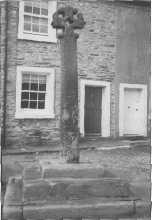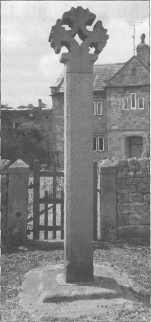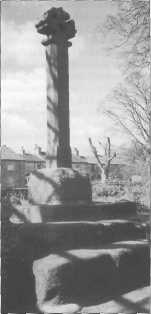| JOURNAL 1999 |
| North Craven Heritage Trust |
There are three very similar roadside crosses, one outside Bolton Peel which is in excellent condition, another in Giggleswick which is the most worn, and the third by the bridge at Clapham, which fits into the middle. The unusual cross head is the same overall design as that found surmounting the Shireburn Chapel at All Hallows Church in Mitton The cross itself consists of three 'fleur de lys', which represent the Trinity and the Virgin Mary, with a cut out diamond in the centre, the points representing the four Evangelists, and the space, Christ.
There are claims that the Giggleswick cross was stolen from Settle, which is debatable. In 1773 Thomas Pennant wrote of Settle, "...a small town in a little vale exactly resembling a shabby French town with a 'place' in the middle. There is a post Medieval Cross in the market place." This cross was originally mounted on a series of rising eight sided steps, which represented eternity and the steps to Calvary with the pillar and orb (the risen sun) on top. This was altered, probably in Victorian times, by additions of an ungainly series of drinking troughs for the base, which apart from 'the water of life', is now paradoxically dried up. The cross in Austwick is the same pillar and orb design.
It is recorded that in 1514 Sir Stephen Hamerton inherited the following lands from his father John, The Manors of Hamerton, Knotsmere, Wigglesworth, Hellifield, Langfield, and a third part of Rishworth; lands at Slaidburn, Newton, Settle, Pheser, Calton and Coniston Cold. On the 25th May 1537 he was executed, after being forcibly pressurised by three to four hundred commoners, to represent their desire for the retention of Sawley Abbey. His lands were confiscated by the crown, and in 1540 Sir Richard Shireburn from Stonyhurst, obtained the lease of the Manor of Wigglesworth and brought the freehold in 1558.
His descendant also called Richard was married to Isabella, the daughter and heiress of John and Isabella Ingeby of Lawkland Hall. In 1666 he and his wife discovered the sulphur spa well at Wigglesworth, and erected a stone edifice around it, complete with drinking cup and door. This is now a grade two listed building, but in a dilapidated condition.
He built almshouses, which were formerly on Kemple End above Hurst Green, and now re-erected in the village, and died in prison in 1689, for ".. .loyalty to his sovereign James I." He left charitable gifts in the townships of Carleton, Chorley, Hamerton, Wigglesworth, Leagram, and Guiseley.
I wrote to the Archivist of the Shireburn family, but he could throw no light on the matter. However when considering the above events, and the position of the crosses, by the then main road, I think they were boundary markers of the Shireburn's newly acquired lands; and after all three is a significant number. Pythagoras considered it to be 'perfect', as it had a beginning, middle and end.
The author was born in Gargrave and later studied at Bretton Hall College which was then music, art and drama. Later she moved to northern Scotland where she taught. Diana lived for ten years in the middle east and Libya. She has four children and has traced her roots back to 1066. For the millennium she would like to build a stone millennium egg in the garden.

J1999p10_19_files/tmpD0B-2.jpg
Giggleswick Cross

J1999p10_19_files/tmpD0B-3.jpg
Boiton Peel Cross

J1999p10_19_files/tmpD0B-4.jpg
Clapham Cross